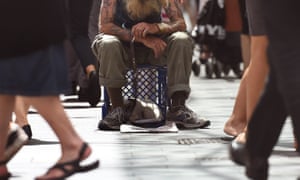Extract from The Guardian
Australia has failed to reduce its level of overall poverty in the community since 2003-04, with 13.3% of the population still living below the poverty line, a new report shows.
There has been a 2% increase in the number of children living in poverty over that period, now 17.4% (731,300 children), according to the Poverty in Australia report published by the Australian Council of Social Service (Acoss) every two years.
The 2016 report indicated persistent and entrenched poverty in Australia. It showed that in 2014 – the latest available data – the poverty line for a single adult was $426.30 week (or $343 after taking into account housing costs).
For a couple with children the poverty line (calculated as 50% of median income) was $895.22 a week (or $720.22 after housing).
Using the after-housing poverty line, it shows the headline poverty rate in 2014 was 13.3%, or 2.99 million people.
It was 11.8% in 2003-04.
Cassandra Goldie, Acoss’s chief executive, criticised Australia’s political leaders for letting the problem fester, calling it a “national shame”.
She said Newstart and Youth Allowance were now $110 and $158 a week below the poverty line respectively.
She said an increase to these payments, of at least $50 a week, would go some way to alleviating poverty and improve people’s chances of finding paid work.
“Unfortunately, our political leaders often seem more concerned with providing the next tax cut than with reducing poverty and inequality,” Goldie said.
“Successive budgets have cut income support payments to those with the least, including low-income families despite persistent and increasing child poverty in Australia. “The low level of unemployment payments is broadly recognised as acting as a direct barrier to securing stable work. And although we have committed to the sustainable development goals, which lists eradicating poverty as goal No 1, we are yet to set a national poverty benchmark, she said.
“We need to shift the mindset that poverty is a reflection of the individual and instead view eradicating poverty as a shared responsibility.”
The report said one area of particular concern was the poverty rate for children in lone-parent families, which increased from 36.8% in 2012 to 40.6% in 2014.
It showed most people below the poverty line relied on social security as their main source of income (57.3%), but a significant proportion received wages as their main income (32%).
This division has not changed significantly from the previous reports, with wage earners comprising about a third of those in poverty in 2010 (29%) and 2012 (33%).
While an overall minority of people receiving social security payments fell under the poverty line in 2014 (36.1%), most Newstart (55%) and Parenting Payment (51.5%) recipients were in this category.
“Our report shows those doing it the toughest are overwhelmingly people living on the $38-a-day Newstart payment, 55% of whom are in poverty. This is followed by families on Parenting Payment (51.5%), the majority of whom are lone parents with children,” Goldie said.
“This report is a further wake-up call to the government to address the inadequacy of the lowest income support payments and bolster support to low-income families through the family payments system. It is also a reminder that housing remains the biggest cost of living issue for households and must be addressed as a policy priority.”
The Acoss report is the fifth such report, published in partnership with the social policy research centre at the University of New South Wales.

No comments:
Post a Comment